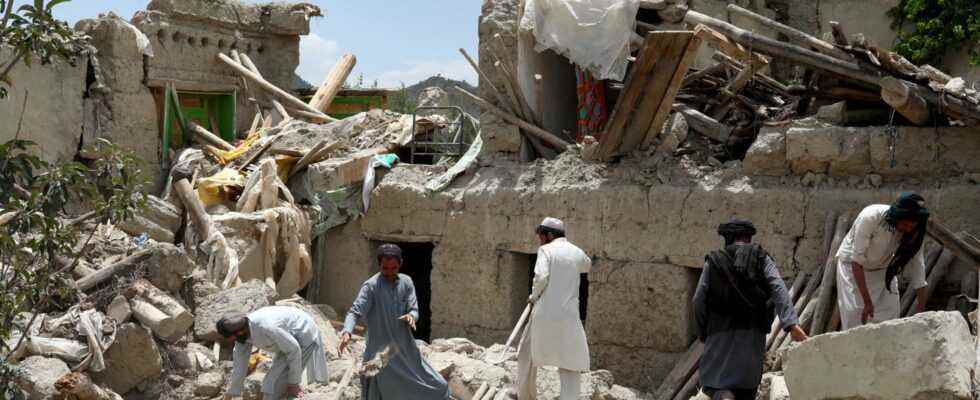Rescuers were desperately trying on Thursday to help victims of the earthquake that killed at least a thousand people in southeastern Afghanistan, but their efforts were hampered by lack of resources, mountainous terrain and heavy rains. .
The earthquake, with a magnitude of 5.9, occurred in the early hours of Wednesday in this poor and difficult to access rural region bordering Pakistan. Already grappling with an economic and humanitarian crisis, Afghanistan is hit by a new tragedy, which poses a heavy challenge for the Taliban, in power since mid-August 2021.
It was the deadliest earthquake in Afghanistan in more than two decades.
At least 1,000 people have died and 1,500 have been injured in the worst affected province of Paktika alone, authorities say, fearing the toll could rise further as many remain trapped under the rubble of their collapsed homes. .
“I was asleep when the earthquake happened… When I came out of my house, everything was silent, because people were buried under their houses,” Zaitullah told AFP on Thursday. Ghurziwal, a resident of Bermal district, Paktika.
“There are no blankets, no tents, no shelters (…). We need food and water. Our whole water distribution system is destroyed. Everything is devastated, the houses are destroyed. People can only pull dead people (rubble) and bury them,” he added.
A very limited number of helicopters and planes
No new report was provided Thursday by the authorities. “It is very difficult to get information from the field because of the poor telephone network,” Paktika provincial information and culture chief Mohammad Amin Huzaifa told AFP.
In addition, “it is difficult to access the affected sites” especially since “the area was hit last night by floods caused by heavy rains”, he added.
These rains caused landslides that slowed relief and damaged telephone and power lines.
The Taliban government has called in the army, but it has few resources. Its financial resources are very limited, after the freezing of billions of dollars in assets held abroad and the abrupt halt to Western international aid, which has carried the country at arm’s length for 20 years and only returns. drop by drop since the return to power of the Islamists.
Afghanistan has only a very limited number of helicopters and planes. The UN, which pointed out that at least 2,000 houses had been destroyed – each being inhabited by at least seven or eight people – also highlighted the lack of clearing equipment. Videos taken on the spot by AFP show people clearing debris from houses with their bare hands in search of bodies.
The Taliban government has said it is doing the best of its abilities and called for help from the international community – which has so far refused to recognize it – and humanitarian organizations.
But international aid is difficult to mobilize, NGOs and UN agencies being less present on the spot than in the past since the return to power of the Taliban.
The Secretary General of the United Nations, Antonio Guterres, nevertheless assured that the UN was “fully mobilized” to help Afghanistan, with the ongoing deployment of first aid teams and the sending of medicines and food.
“It’s a humanitarian crisis. It’s like a tsunami”
The population needs shelter in priority, because of the rains and the unusual cold in this season, but also food and non-food aid and assistance in water, hygiene and sanitation services, indicated the Bureau. for the coordination of humanitarian affairs (Ocha) of the United Nations.
The Taliban announced on Thursday that they had received two planes loaded with aid from Iran, and one from Qatar. Eight trucks loaded with food and first aid supplies from neighboring Pakistan have also arrived in Paktika province.
The European Union also said on Wednesday that it was ready to “provide emergency aid”. “Deeply saddened”, the United States announced to examine their “response options” humanitarian.
Severely under-equipped, the Afghan health system is also under great pressure. “Our country is poor and lacks resources. It’s a humanitarian crisis. It’s like a tsunami,” Mohammad Yahya Wiar, director of the hospital in Sharan, capital of Paktika, told AFP.
Afghanistan is frequently hit by earthquakes, particularly in the Hindu Kush mountain range, which lies at the junction of the Eurasian and Indian tectonic plates. These disasters can be particularly destructive due to the low resilience of rural Afghan homes.
The deadliest earthquake in the recent history of Afghanistan (5,000 dead) took place in May 1998 in the provinces of Takhar and Badakhshan (north-east).
